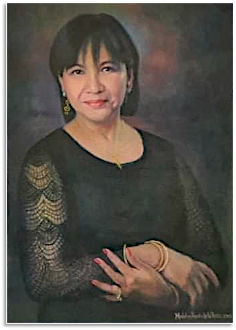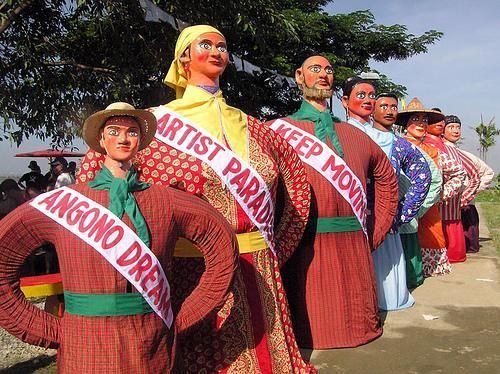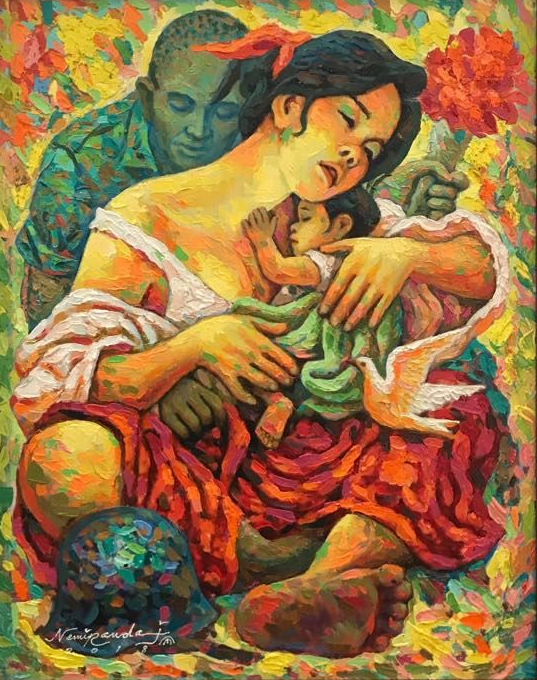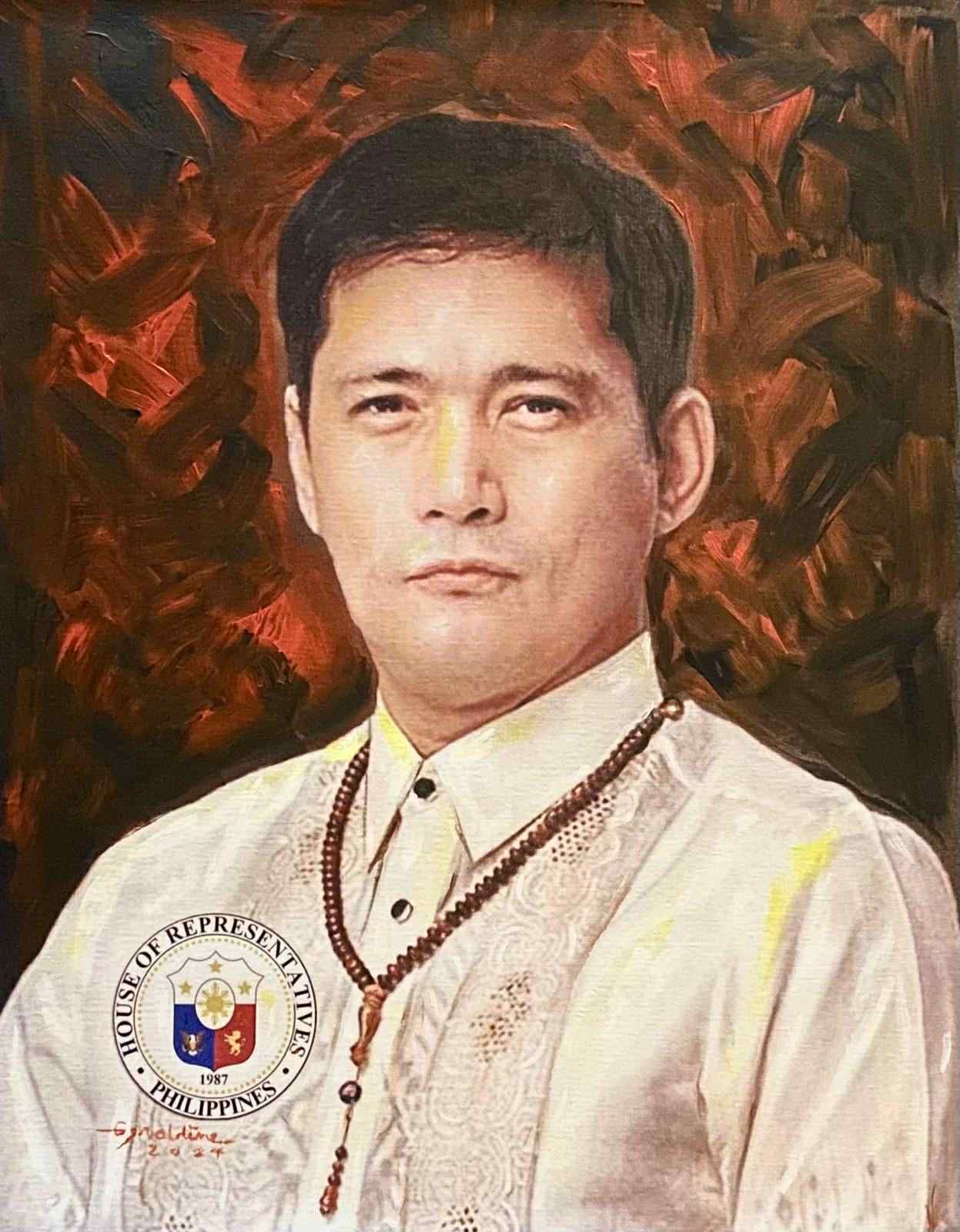Mary Ann Tirol Kimpo was born in Davao City. She is married to Ali Al Sherhri and has two kids named Tammy and Ricky, respectively. They have made the Philippines their official home and built a Mideast Restaurant in Boracay Island in D’ Mall- Baharat- Kabsa Steakhouse.
She is the youngest of seven children. Her father is the late judge Ramon Escalona Kimpo and her late mother, Edna Elsie Gonzales Tirol, a papal awardee” Pro E Pontifice” from Pope Pius Xll for her church work. Her grandparents were Judge Lamberto Hontiveros Tirol and Sofia Ner Gonzales, the “greener” and “discoverer” of Boracay Island. She always brings her kids to Boracay while vacationing to meet with their relatives and know their roots.
She loves doing and joining extracurricular activities like acting, dancing, singing, and writing from elementary to college. Despite being active in these activities, she was still a dean’s lister at the Philippine Women’s University as she finished her degree in Medical Technology in same university and graduated her Pre-Medicine at Ateneo de Davao. Despite her activities, she manages to stay her name in the honors’ list in her class during elementary and high school years.
Before the Martial Law era, she wrote for THE ATENEWS, the school paper of Ateneo de Davao, and The Sheild Yearbook. She was the Secretary of the Student Council as well. Writing played an essential role in her student life and later. After Pre-Med in Ateneo, her parents decided to send her to Manila to study.
In Manila, she went to PWU; here, she again wrote for the PHILWOMENIAN, the university newspaper. She went to GSIS General Hospital in East Avenue and worked as an Intern in their laboratory. Later on, she landed a job at the Philippine Heart Center for Asia and writing feature stories for PINTIG, the hospital magazine. To note, she is one of the pioneers of the said hospital.
In 1979, she was in the second planeload of Overseas Contract Workers bound for Saudi Arabia, where she met her husband, Ali Alshershi. They went through a lot of difficulties to get married; Saudis were not allowed to marry foreigners. With that difficulty hanging in the air, they decided to move to the United States, earning a US visa to get married in the United States. They got married in Las Vegas. Mary Ann found worked in the laboratory in Permian General Hospital.
Then the document finally arrived, granting Ali’s family to join him in Jeddah. And Mary Ann went back with Thamara to Jeddah. She found the Saudis to be good and friendly people, except that they have different traditions and customs that one must strictly follow.
After Tariq (Ricky), her youngest, was born, she went back to work with the Ministry of Health as a Laboratory Specialist in Jeddah until her retirement. While she was there, she joined the Filipino Community not to miss her lifestyle in the Philippines. Ali, her husband, was understanding enough to let her and her children join the Saudi, Filipino, American activities.
The Kuwait-Iraqi war gave them a good reason to send their children to the Philippines. It was not difficult for the children because they always sent them to the Philippines or the US for vacations. Her parting words to them were to “get the best of both worlds.”
After retiring, Mary Ann and her husband joined their children in the Philippines. Her husband went into the restaurant business.
Mary Ann is an active civic leader, her organizations past and present, namely Board of Director of the Ladislawa Association for six years; President of the Mt. Talomo International Lions Club; Officer of the Ageless Society of Ladislawa Association and currently a Trustee of the Board of Megaworld’s and Global-Estate Resorts (GERI) Oceanway Residences in Newcoast, Boracay Island.
Her daughter Thamara moved to New York with daughter Tara. Thamara graduated with a degree in MS Behavioral Science and Health promotion in New York. She continued her studies, trying to finish her Ph.D.
On the other hand, while Maryann visited New York, she took a refresher voice course with the New York Vocal Coaching of Justin Stone as a coloratura.
A few months before the 2020 Pandemic, Mary Ann brought their children back to the Philippines where Tammy is currently taking up Law.
Their son Ricky (Tariq) is married to Joyce, and they have two children Johann and Baby Maryam. Ricky is a graduate of Computer Science.
Mary Ann also bakes cakes. Her cakes are “Character -like,” mostly 3-D like the doll cakes.
As a coloratura, she holds musical nights and participates in charitable events with her voice coach and accompanist Rogerbert Goleng, Jr. and violinist Robert Stormowski from Poland. Now, thanks be to God, the family says, as they are all together now, especially in these troubled times, they are all staying together in their family compound in Davao City.

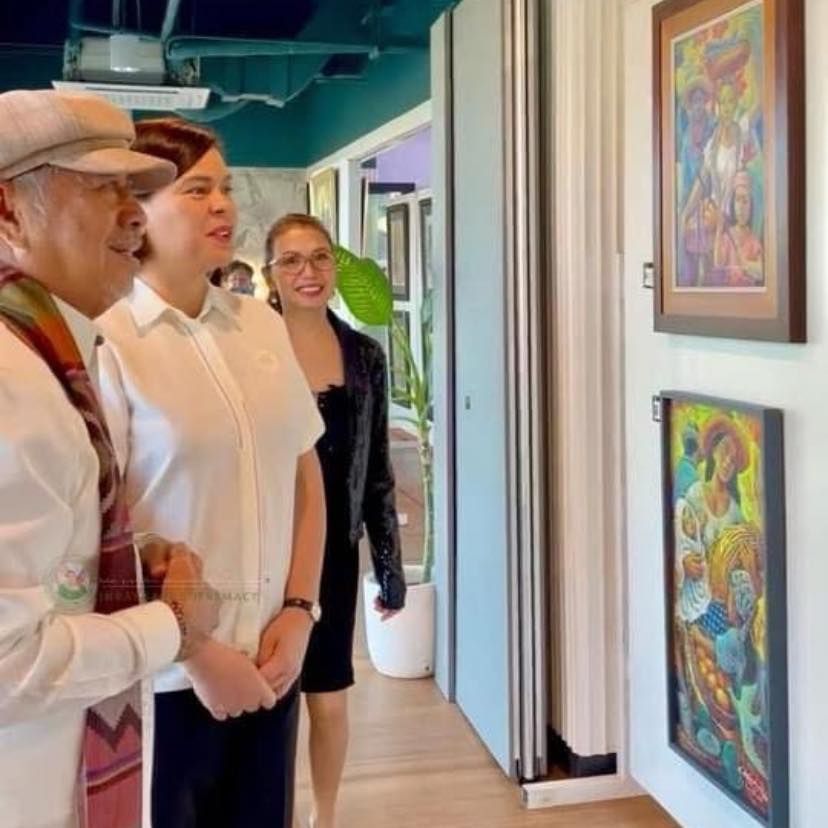
Click the video weblink below to watch the event in full.
https://www.facebook.com/EuropePinoyMediaNetwork/
Inday Sara Duterte @ Nemi Miranda Art Expo & Artbook Launching Authored by Geraldine Hernandez-Martens, Ph.D.
Coming Soon :
Art Expo & Artbook Launching 2025-2026. Almost 100 artists participated in this said coffee table size, hardbound, full-color artbook with almost 400 glossy paper pages.
Eurointermedia International in cooperation with Europe Pinoy Media Network & Giselle Sanchez in "Go Green Worldwide Campaign" to build School for Gifted Children & Children with Special Needs.

Aangono Higantes are giant paper-mache creations endemic in the history and culture of Angono. For adults, they symbolize joy and festivity, especially when they are moving, swaying, and dancing. For kids, however, they evoke amusement or fear during the Higantes Festival celebrated on November 22-23 by the Municipality of Angono, Rizal, known as the Art Capital of the Philippines.
The festival is celebrated alongside the feast of St. Clement, Angono’s patron saint of fishermen. This year, the activities feature tiangge, play, band and rock concerts, a talent search, a dance contest known as “Parehadora Festival,” a parade, and an art exhibit welcoming the centennial of National Artist for Painting Carlos “Botong” Francisco in 2012.
Local folklore discussed in the research books of UP emeritus professor Ligaya Tiamson-Rubin noted that the Higante was used as a symbol of agrarian protest during the waning years of Spanish colonialism.
A UP art studies thesis written by Lisa Ito also considered Higante as the first political effigy in the country.
Based on the story, the face of the first Higante was similar to the landlord’s image who, at that time, decided to hire farm workers from Morong, Rizal instead of Angono natives. His bulging eyes and his hands encircling his waist making a boastful and arrogant stance, caught the sarcasm and satire of Angono natives.
In the 1940s, National Artist Carlos “Botong” Francisco used the Higante to punctuate the festive parade of the town fiesta to counter the gloom hovering over post-World War II Angono.
In his research done three years ago, James Owen Saguinsin, a native of Angono and professor of art studies at the Far Eastern University, even claimed that the Higante was a
In the ‘70s, the son of the Higante couple, which the people called “Anak ng Higante” or “Maliit na Higante,” was introduced in the public’s consciousness and comprised what is now known as the Original Higante Family. The head of the Higante is made of paper-mache while the body used to be created using bamboo strips.
Today, most Higante bodies are made of thin aluminum because bamboo has become scarce. This also makes the Higante lighter, which makes it easier to carry, especially when it is transported to various parts of the country.
In Angono, a group of craftsmen called HIMASS or Higante Makers and Sculptors Society take the lead role in the reproducing these images. Artists Nemi Miranda, the Blanco Family, and Toti Argana also have their own Higante.
Last year, during the Feast of San Isidro, Toti introduced the Maliliit na Higanteng Bahay Kubo or the vegetables identified in the Filipino folk song. The Higante was also used during the interment of artist and Balaw-Balaw Restaurant founder Perdigon Vocalan about a decade ago.
Vocalan is credited with exhibiting in Japan and abroad the Higante which was folded, detachable and could be assembled in a few minutes.
Artist Wire Rommel Tuazon also used the heads of the Higante in one of his art installations exhibited at the Cultural Center of the Philippines in early 2000.
Last year, the Higante became an electoral tool as dozens of these images bearing the faces of politicians like Jejomar Binay and Noynoy Aquino were used in campaign gatherings.
Some artists, however, criticize the use of the Higante as a “giant walking billboard” which has been appropriated by private companies and overrun by unmitigated commercialism.
In the early 1990s, the Municipality of Angono popularized the Higantes Festival as part of its “One Town, One Product” campaign of the Department of Trade and Industry. It eventually got listed in the recognized festivals of the Department of Tourism and became popular and at a par with Davao’s “Kadayawan,” Cebu’s “Sinulog” and Iloilo’s “Dinagyang” festivals watched and visited by both local and foreign tourists.
During the administration of Mayor Aurora Villamayor in 2008, the “Karera ng Higante” was introduced during the town fiesta, a reinvention of the “Karera ng Kalabaw” or “Carabao Race.”
Today, though, the Municipality of Angono considers the Higante as the symbol of the collective effort to drumbeat the town’s huge and significant contribution, especially in local governance as well as the national cultural and arts scene.
“This year’s celebration highlights Angono’s place in the country as truly the haven of artists and creativity,” Mayor Gerry Calderon said. He added that the Higante refers to the achievements of the municipality for localizing and replicating the MDGs or Millennium Development Goals of the United Nations.
MDGs, which provide a framework in making sure that human development reaches everyone, were adopted by world leaders in the year 2000 and set to be achieved by 2015.
The eight MDGs break down into 21 quantifiable targets that are measured by 60 indicators. The MDGS include the following: eradicate extreme poverty and hunger; achieve universal primary education; promote gender equality and empower women; reduce child mortality; improve maternal health; combat HIV/AIDS, malaria and other diseases; ensure environmental sustainability; and a global partnership for development.
Mayor Calderon’s replication of the MDGs has not gone unnoticed. Under his watch, the municipality has received various commendations such as
“Gawad Galing Pook,”
the World Art Experience and the recognition of Angono as
“ASEAN Culture Capital”
by the National Commission for Culture and the Arts and Cultural Center of the Philippines.












